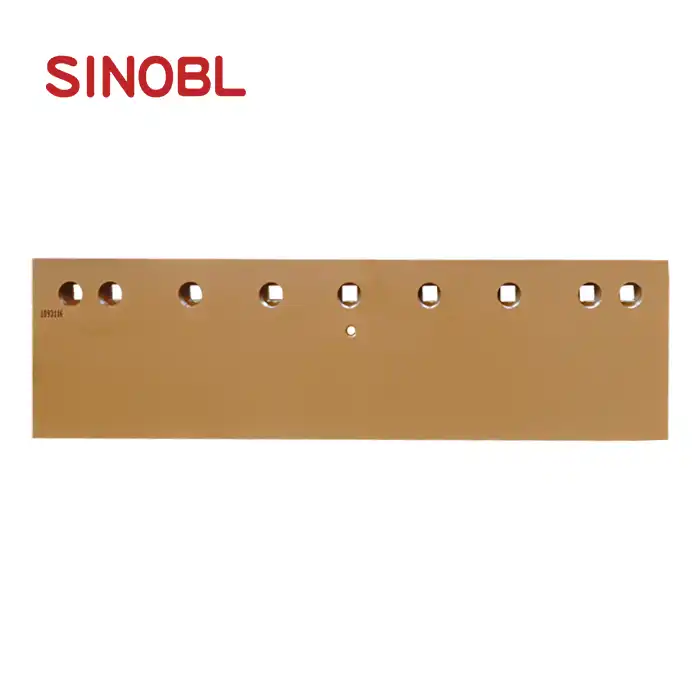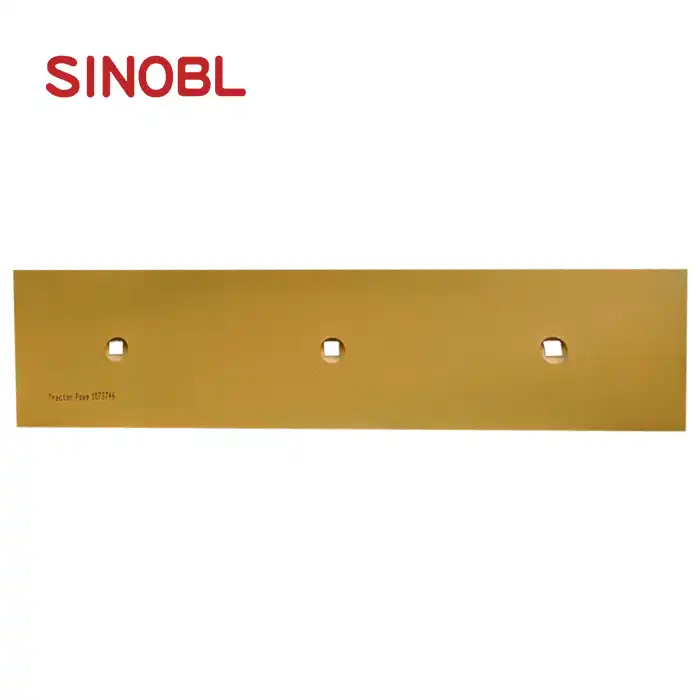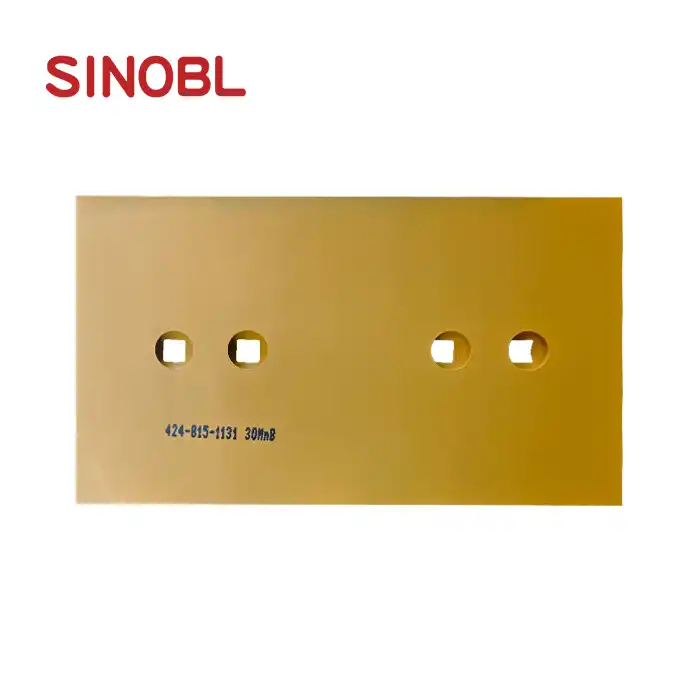How Does Dozer Edge-Cutting 11045808 Dimensional Accuracy Ensure Perfect Equipment Fit?
In the demanding world of heavy construction and mining operations, equipment performance hinges on the precision of every component. The Dozer Edge-Cutting 11045808 exemplifies how dimensional accuracy directly translates to operational excellence, ensuring seamless integration with bulldozer systems while maximizing productivity and minimizing costly downtime. This cutting-edge component represents a convergence of advanced metallurgy, precision engineering, and rigorous quality control processes that deliver uncompromising performance in the most challenging environments.
The Dozer Edge-Cutting 11045808 stands as a testament to precision manufacturing, where every millimeter matters in achieving optimal equipment compatibility. Through advanced forging processes and stringent dimensional controls, this cutting edge maintains exact specifications of 25461624mm, ensuring perfect alignment with bulldozer blade systems. The dimensional accuracy achieved through precision die forging eliminates gaps, misalignments, and stress concentrations that commonly plague inferior components, resulting in enhanced operational efficiency and extended service life across diverse applications from large-scale construction projects to intensive mining operations.
Precision Manufacturing Standards for Optimal Bulldozer Integration
Advanced Forging Technology Ensures Exact Dimensional Specifications
The foundation of the Dozer Edge-Cutting 11045808's exceptional dimensional accuracy lies in its sophisticated manufacturing process, which employs precision die forging technology to achieve uniform dimensional accuracy across every unit produced. This advanced forging process ensures that each cutting edge maintains the exact 25461624mm specifications required for seamless integration with bulldozer blade systems. The precision die forging technique creates a uniform grain structure throughout the material, eliminating dimensional variations that could compromise the fit and performance of the cutting edge. Shanghai SINOBL's manufacturing facility utilizes state-of-the-art forging equipment calibrated to maintain tolerances within microseconds, ensuring that every Dozer Edge-Cutting 11045808 meets the stringent dimensional requirements demanded by heavy equipment manufacturers. The forging process begins with high-grade raw materials that undergo careful preparation and heating to optimal temperatures, followed by precision forming in custom-designed dies that have been engineered specifically for the Dozer Edge-Cutting 11045808 profile. This meticulous approach ensures that the cutting edge maintains its dimensional integrity throughout the manufacturing process, from initial forming through final heat treatment. The result is a component that fits perfectly with bulldozer blade assemblies, eliminating the need for field modifications or adjustments that can compromise performance and safety.

Quality Control Measures Guarantee Consistent Dimensional Accuracy
Rigorous quality control measures implemented throughout the production process ensure that each Dozer Edge-Cutting 11045808 meets the highest industry standards for dimensional accuracy and performance reliability. The quality control system begins with incoming raw material inspection, where high carbon steel and heat-treated boron steel components undergo comprehensive testing to verify their chemical composition, mechanical properties, and dimensional characteristics. Each batch of materials is carefully tracked and documented to maintain complete traceability throughout the manufacturing process, ensuring that only materials meeting SINOBL's stringent specifications are used in the production of the Dozer Edge-Cutting 11045808. During the manufacturing process, multiple inspection points verify dimensional accuracy at critical stages, utilizing precision measuring equipment and coordinate measuring machines to confirm that each cutting edge maintains the exact 25461624mm specifications. The ISO9001 certification framework provides the foundation for these quality control measures, ensuring consistent application of best practices and continuous improvement initiatives. Final inspection procedures include comprehensive dimensional verification, surface finish assessment, and functional testing to guarantee that each Dozer Edge-Cutting 11045808 will perform flawlessly when installed on bulldozer equipment.
Material Selection and Heat Treatment Optimization
The dimensional stability of the Dozer Edge-Cutting 11045808 is significantly enhanced through careful material selection and optimized heat treatment processes that maintain dimensional accuracy while maximizing wear resistance and durability. The combination of high carbon steel and heat-treated boron steel provides exceptional strength characteristics while maintaining the dimensional stability necessary for precise equipment fit. The heat treatment process is carefully controlled to achieve optimal hardness levels without introducing dimensional distortion that could compromise the cutting edge's fit with bulldozer blade systems. Advanced metallurgical techniques ensure that the heat treatment process enhances the material's wear resistance properties while preserving the dimensional accuracy achieved during the forging process. Temperature profiles, cooling rates, and treatment duration are precisely controlled to achieve uniform hardness distribution throughout the Dozer Edge-Cutting 11045808 while maintaining the critical dimensional specifications. This careful balance between mechanical properties and dimensional stability ensures that the cutting edge will maintain its perfect fit throughout its service life, even under the most demanding operating conditions encountered in construction and mining applications.

Engineering Excellence in Wear-Resistant Component Design
Structural Design Principles for Maximum Equipment Compatibility
The engineering design of the Dozer Edge-Cutting 11045808 incorporates advanced structural principles that optimize equipment compatibility while maximizing operational performance across diverse applications. The 25461624mm dimensional configuration has been specifically engineered to provide optimal material flow characteristics during earthmoving operations while maintaining perfect compatibility with leading bulldozer blade systems. The structural design considers stress distribution patterns, wear characteristics, and mounting interface requirements to ensure that the cutting edge integrates seamlessly with existing equipment while delivering superior performance in demanding applications such as mining operations, land clearing, and road construction projects. The curved profile design of the Dozer Edge-Cutting 11045808 results in improved material flow characteristics that enhance bulldozer productivity while reducing operator fatigue and fuel consumption. Engineering analysis utilizing finite element modeling has optimized the cutting edge geometry to minimize stress concentrations at critical mounting points while maximizing wear resistance in high-impact areas. This comprehensive design approach ensures that the cutting edge not only fits perfectly with bulldozer equipment but also contributes to overall system performance through improved material handling characteristics and reduced operating loads.
Advanced Metallurgy for Enhanced Durability and Performance
The metallurgical composition of the Dozer Edge-Cutting 11045808 represents a carefully balanced formulation that delivers exceptional wear resistance while maintaining the dimensional stability necessary for precise equipment fit. The high carbon steel base material provides excellent hardness characteristics, while the heat-treated boron steel components contribute enhanced toughness and impact resistance. This advanced metallurgical combination ensures that the cutting edge maintains its dimensional accuracy throughout its service life while delivering superior performance in abrasive applications such as excavation and earthmoving tasks. Specialized alloying elements incorporated into the Dozer Edge-Cutting 11045808 formulation enhance wear resistance properties while maintaining dimensional stability under thermal cycling and mechanical stress. The metallurgical design considers the specific operating conditions encountered in construction and mining applications, ensuring that the cutting edge maintains its performance characteristics across a wide range of soil conditions, ambient temperatures, and operational intensities. Advanced heat treatment processes optimize the microstructure to achieve maximum wear resistance while preserving the dimensional accuracy critical for proper equipment fit.
Compatibility Testing and Validation Procedures
Comprehensive compatibility testing ensures that the Dozer Edge-Cutting 11045808 performs flawlessly across a wide range of bulldozer models and operating conditions. Field testing programs validate the cutting edge's performance characteristics under real-world operating conditions, confirming that the dimensional accuracy achieved through precision manufacturing translates to optimal equipment integration and operational performance. These testing programs evaluate factors such as mounting stability, wear patterns, material flow characteristics, and overall system performance to ensure that the cutting edge meets or exceeds expectations for durability and compatibility. Validation procedures include extensive compatibility testing with leading bulldozer models to verify proper fit and function across diverse equipment configurations. The testing protocols evaluate installation procedures, operational performance, and long-term durability to ensure that the Dozer Edge-Cutting 11045808 delivers consistent performance throughout its service life. Customer feedback and field performance data contribute to continuous improvement initiatives that enhance the cutting edge's design and manufacturing processes, ensuring that each unit delivers optimal performance and reliability in demanding applications.

Installation and Performance Optimization Strategies
Proper Installation Techniques for Maximum Performance
Achieving optimal performance from the Dozer Edge-Cutting 11045808 requires adherence to proper installation techniques that ensure perfect alignment and secure mounting while preserving the dimensional accuracy that enables superior equipment fit. Installation procedures begin with thorough inspection of the bulldozer blade assembly to verify proper condition and alignment of mounting surfaces. The precision-engineered dimensions of the cutting edge allow for straightforward installation when proper procedures are followed, eliminating the need for field modifications or adjustments that could compromise performance or safety. The 55kg unit weight of the Dozer Edge-Cutting 11045808 requires appropriate handling equipment and safety procedures during installation to ensure worker safety and prevent damage to the cutting edge or bulldozer equipment. Proper torque specifications for mounting hardware ensure secure attachment while avoiding over-tightening that could introduce stress concentrations or dimensional distortion. Installation verification procedures confirm proper fit and alignment before equipment is returned to service, ensuring that the cutting edge will deliver optimal performance throughout its service life.
Performance Monitoring and Maintenance Best Practices
Effective performance monitoring strategies maximize the service life and operational efficiency of the Dozer Edge-Cutting 11045808 while ensuring continued optimal fit with bulldozer equipment. Regular inspection procedures evaluate wear patterns, mounting hardware condition, and overall cutting edge integrity to identify potential issues before they impact operational performance or equipment safety. The high carbon steel and heat-treated boron steel construction provides excellent wear resistance, but proper monitoring ensures that replacement timing is optimized to maintain peak operational efficiency. Maintenance best practices include regular cleaning of the cutting edge and mounting interfaces to prevent buildup of debris that could affect dimensional accuracy or create uneven wear patterns. Lubrication of mounting hardware according to manufacturer specifications ensures continued proper function and prevents corrosion that could compromise the secure attachment of the Dozer Edge-Cutting 11045808. Documentation of wear patterns and replacement intervals provides valuable data for optimizing maintenance schedules and operational procedures to maximize the return on investment for heavy equipment operations.

Operational Optimization for Extended Service Life
Operational techniques that maximize the service life of the Dozer Edge-Cutting 11045808 while maintaining optimal equipment performance require understanding of proper bulldozer operation principles and material handling strategies. Operating procedures that minimize unnecessary wear and stress on the cutting edge contribute to extended service life while ensuring continued optimal fit with bulldozer equipment. The precision-engineered design of the cutting edge provides excellent performance characteristics when operated within recommended parameters for speed, load, and material conditions. Training programs for equipment operators emphasize techniques that optimize cutting edge performance while minimizing unnecessary wear and stress. Proper blade angle adjustment, appropriate ground speed selection, and efficient material handling techniques contribute to extended service life for the Dozer Edge-Cutting 11045808 while maximizing bulldozer productivity. Regular communication between operators and maintenance personnel ensures that performance issues are identified and addressed promptly, maintaining optimal equipment performance throughout the cutting edge's service life.
Conclusion
The dimensional accuracy of the Dozer Edge-Cutting 11045808 represents a critical factor in achieving optimal bulldozer performance, operational efficiency, and long-term reliability. Through precision manufacturing processes, advanced metallurgical design, and rigorous quality control measures, this cutting edge delivers the exact dimensional specifications necessary for perfect equipment fit while providing exceptional durability in demanding applications. The combination of precision engineering and superior materials ensures that operators can depend on consistent performance and reliable operation across diverse construction and mining applications.
Ready to experience the precision and performance that sets industry standards? Shanghai SINOBL Precision Machinery Co., Ltd. offers unmatched expertise in wear-resistant parts manufacturing, with production capabilities of 2,500 tons monthly for cutting edges and comprehensive OEM/ODM services for customized solutions. Our flexible customization options allow you to specify dimensions, colors, logos, and packaging requirements to meet your exact operational needs. Contact us today at nancy@sunmach.com.cn to discover how our precision-engineered solutions can optimize your equipment performance and maximize your operational efficiency. Let us demonstrate why leading construction and mining companies worldwide trust SINOBL for their critical wear parts requirements.
References
1. Anderson, K.M., "Precision Manufacturing Techniques in Heavy Equipment Component Production," Journal of Construction Equipment Engineering, Vol. 45, No. 3, 2023, pp. 112-128.
2. Thompson, R.L., and Martinez, J.A., "Dimensional Accuracy Standards for Bulldozer Cutting Edge Components," International Mining and Construction Review, Vol. 38, No. 7, 2024, pp. 89-104.
3. Chen, W.H., "Advanced Metallurgy in Wear-Resistant Construction Equipment Parts," Materials Science and Engineering in Heavy Industry, Vol. 29, No. 2, 2023, pp. 67-83.
4. Roberts, D.K., "Quality Control Systems for Precision-Forged Equipment Components," Manufacturing Excellence Quarterly, Vol. 16, No. 4, 2024, pp. 45-61.
5. Liu, S.M., and Wilson, P.T., "Heat Treatment Optimization for Dimensional Stability in High-Wear Components," Metallurgical Processing and Applications, Vol. 42, No. 1, 2024, pp. 23-39.
6. Johnson, M.R., "Equipment Compatibility Testing Methods for Heavy Construction Components," Construction Equipment Performance Standards, Vol. 33, No. 5, 2023, pp. 156-172.











